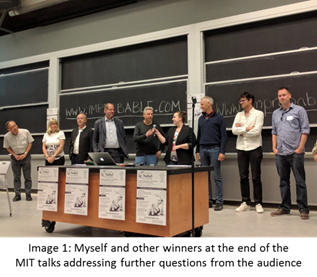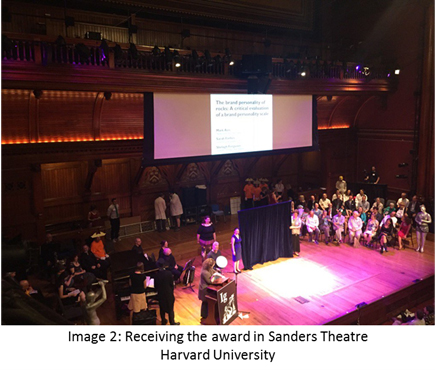Sarah Forbes at the Ig Nobel awards
This year my New Zealand colleagues and I were nominated and awarded an Ig Nobel which took us to Harvard University to accept the award and to Massachusetts Institute of Technology (MIT) to present our research. For anyone that is unfamiliar with the Ig Nobels, these are awards for research that will first make you laugh, and then make you think. While research literature may not necessarily be known for being humorous, humour is quite a useful tool to make it accessible and digestible (not to mention memorable) for someone outside of the specific area. With many top journals having a broad scope and audience, humour can make the idea easier to understand and stand out for its untraditional approach.
What was the research that won the award?
 The study surrounds a very common marketing scale measuring brand personality which operates on the premise that brands have human characteristics associated with them. We did not necessarily go out of our way to write something that was funny but our argument employed reductio ad absurdum to reveal that the brand personality scale, to put it lightly, is absurd. My question to you the reader is, would you look at Cottonelle toilet paper and consider its intelligence? I’m guessing you wouldn’t. Well, it is sad to say, but this is exactly what this scale would force you to question and your response alongside others participant responses would be used to measure brand personality of that brand. Now you are probably thinking that this is a ridiculous notion, but the brand personality scale has received over 6,000 citations with many more added each year.
The study surrounds a very common marketing scale measuring brand personality which operates on the premise that brands have human characteristics associated with them. We did not necessarily go out of our way to write something that was funny but our argument employed reductio ad absurdum to reveal that the brand personality scale, to put it lightly, is absurd. My question to you the reader is, would you look at Cottonelle toilet paper and consider its intelligence? I’m guessing you wouldn’t. Well, it is sad to say, but this is exactly what this scale would force you to question and your response alongside others participant responses would be used to measure brand personality of that brand. Now you are probably thinking that this is a ridiculous notion, but the brand personality scale has received over 6,000 citations with many more added each year.
Based on our knowledge of the very dubious research the brand personality scale was reliant on (clear within the addendum of the article) my colleagues Dr Mark Avis, Dr Shelagh Ferguson and I believed that the brand personality scale actually developed what was measured, i.e., the idea of brand personality only exists because of the measurement scale.
To test this, and utilise reductio ad absurdum, we applied the brand personality scale to rocks to demonstrate that the methodology actually creates brand personality on whatever the stimuli is and that the participants were willing to help us. When looking at the results at the time, we were actually quite impressed at how much they wished to follow/ partake in the brand personality scale methodology. Not only that, participants were generating very elaborate perceptions to aid their completion of the survey methodology, such as one participant saying one of the rocks was a corporate sort that would backstab people to get ahead and another one that lived on the Otago Peninsula (area outside of Dunedin, New Zealand) raising chickens. Now don’t forget, this was a rock and this came as a result of the methodology.
These results were incredibly interesting but they were also somewhat alarming given that participants were developing these elaborate strategies to complete the survey during the research process. In doing this, these participants helped us to show that the brand personality scale, which also uses forced choice, leading questions, personification and acquiescent responding, is actually creating brand personality. If a researcher did not use the measurement scale, a participant would not ordinarily use the terms to describe the brand and the personality would not exist. Given that so much research is completed using this scale, and so many consulting firms use and charge organisations to learn about it, it was important to step out and disprove the existence of it. Therefore, using rocks was amusing but the message is serious.
Back to the Ig Nobels …. The ceremony
 Our trip to Harvard University was an eventful one where we met Nobel laureates and fellow winners from around the world. The actual ceremony itself was amusing, funny and sometimes, just plain odd. From NASA scientists playing a game of tic-tac-toe against Nobel laureates on stage, to the 24-7 lectures (24 seconds to discuss your field followed by a 7 word summary), it was a hoot. In amongst all of these rather fun events, my colleagues and I were awarded our Ig Nobel in Economics by 2007 Nobel prize winner Professor Eric Maskin (Economics) who was both friendly and very willing to play his part during the course of the ceremony. At the end of all this, we walked away with a ginormous 61 second clock, my very own one trillion Zimbabwe dollars and a certificate signed by three Nobel laureates. What can I say, the Ig Nobels rock.
Our trip to Harvard University was an eventful one where we met Nobel laureates and fellow winners from around the world. The actual ceremony itself was amusing, funny and sometimes, just plain odd. From NASA scientists playing a game of tic-tac-toe against Nobel laureates on stage, to the 24-7 lectures (24 seconds to discuss your field followed by a 7 word summary), it was a hoot. In amongst all of these rather fun events, my colleagues and I were awarded our Ig Nobel in Economics by 2007 Nobel prize winner Professor Eric Maskin (Economics) who was both friendly and very willing to play his part during the course of the ceremony. At the end of all this, we walked away with a ginormous 61 second clock, my very own one trillion Zimbabwe dollars and a certificate signed by three Nobel laureates. What can I say, the Ig Nobels rock.
The talk at MIT and lasting impact of the Ig Nobel awards
We were very pleased and lucky to have had the opportunity to present our research at MIT a couple of days after the ceremony. Here, the organisers did a great job of promoting the talks and inviting many people from MIT to attend. We rose to the occasion as we saw this as our chance to further promote the work and the audience seemed to thoroughly enjoy it as well as understand the serious nature of the research. The feedback was very encouraging and we could not have achieved this reach if it wasn’t for the Ig Nobel awards.
For any researcher, it is hoped that many people would read their work. For us, this experience offered a level of exposure that could not have been anticipated and we are incredibly grateful. In addition to the numerous interview requests we have had regarding the research, newspapers have taken it upon themselves to read and accurately report the research. Academics from around the world have also contacted us and offered very positive feedback on the paper and we couldn’t be happier. We were very lucky to have Sage publishers on side to further promote our paper and with all of this publicity, the sheer interest and ‘reads’/downloads of our paper has skyrocketed. Ultimately, the Ig Nobels may be viewed in a particular way but with the experience we have had, it was worth it.
Full reference of the paper:
Avis, M., Forbes, S., & Ferguson, S. (2014). The brand personality of rocks: A critical evaluation of a brand personality scale. Marketing Theory, 14(4), 451-475. http://mtq.sagepub.com/content/14/4/451